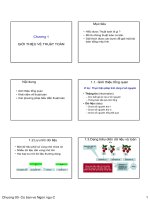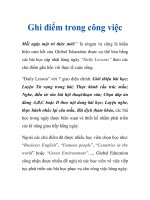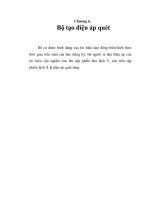Kĩ thuật ghi điểm trong toeic 6 ppt
Bạn đang xem bản rút gọn của tài liệu. Xem và tải ngay bản đầy đủ của tài liệu tại đây (80.3 KB, 6 trang )
MEANING EXAMPLE
horizontal, level The prairie is flat.
spread out, lying at full length He fell flat on his face.
smooth and even The stone was flat.
absolute, unqualified She was flat broke.
dull, monotonous The story was flat.
(regarding carbonated beverages) having
lost its effervescence (bubbles) The Coke was flat.
(in music) below the correct pitch Her singing is flat.
deflated The tire was flat from running over a nail.
■
Make connections. Any time you make connections between ideas, you improve your chances of
remembering that material. For example, if Spanish is your native language, you might make the fol-
lowing connection:
dormir = to sleep in Spanish
dormitory = room with beds for students to sleep
■
Write your reactions. Your reactions work much like connections, and they can help you remember
information. For example, if you read “It’s raining cats and dogs out there!” you might write:
What an odd expression! Funny image. Easy to remember.
Outlining and Mapping Information
Outlines are great tools, especially for sequential learners. They help you focus on what’s most important by
making it easier to review key ideas and see relationships among those ideas. With an outline, you can see how
supporting information is related to main ideas.
The basic outline structure is this:
I. Topic
1. Main idea
a. major supporting idea
i. minor supporting idea
Outlines can have many layers and variations, but this is the general form. Here’s an example: V
erb +
up
and out
I. Make up
1. to determine
a. example: I made up my mind to pass the exam.
2. to invent
a. example: He made up a good excuse.
3. to compensate, repay
a. example: She will make up for her mistake by doing extra work.
– HOW TO PREPARE FOR THE TOEFL
®
EXAM–
11
II. Make out
1. to see clearly
a. I can barely make out what this says.
2. to fare (get through or do something)
a. How did you make out during the interview?
3. slang: to French kiss
a. The teenagers made out during the whole movie.
Mapping information is similar to making an outline. The difference is that maps are less structured.
You don’t have to organize ideas from top to bottom. Instead, with a map, the ideas can go all over the page.
The key is that you still show how the ideas are related. Here’s the same example in a map instead of an out-
line:
Making Flashcards
Flashcards are a simple but very effective study tool. First, buy or cut out small pieces of paper (3x5 index cards
work well). On one side, put a question or word you need to learn. On the back, put the answer. You can use
different colors and pictures, especially if you are a visual learner.
make up
to invent
example: He made
up a good excuse.
to compensate,
repay
example: She will make
up for her mistake by
doing extra work.
to determine
example: I made up my
mind to pass the exam.
– HOW TO PREPARE FOR THE TOEFL
®
EXAM–
12
For example, if you are studying the past tense and participles of transitive and intransitive verbs, you
could make flash cards like the following:
FRONT OF CARD BACK OF CARD
FRONT OF CARD BACK OF CARD
FRONT OF CARD BACK OF CARD
FRONT OF CARD BACK OF CARD
Memorizing versus Remembering
Imagine that you need to memorize a list of irregular verbs for the TOEFL exam. You go over and over the
list until you are sure you know them. Then you take a practice test. Suddenly, you can’t seem to remember
the list. The verbs are used in context (within sentences), and they are not in the order you memorized. You
fail the practice test.
What happened? The problem is not that you didn’t study. The problem is that you didn’t study wisely.
You focused on memorizing, not remembering. You didn’t learn the words in context. You didn’t use the verbs
or practice them by writing sample sentences. That’s why, on the test, you couldn’t remember them.
It’s true that “repetition is the key to mastery.” Try repeating a new phone number over and over, for
example. Eventually you will remember it. But it may only stay in your short-term memory. In a few days (or
maybe even a few hours), you are likely to forget the number. You need to use it to really learn it and store
the information in your long-term memory. While there are some tricks you can use to help remember things
in the short term, your best bet is to use what you are learning as much as possible and as soon as possible.
For example, you can use new vocabulary words or idioms in your conversations throughout the day. You can
also teach the new word or idiom to others. Here are some general strategies to help you remember infor-
mation as you prepare for the TOEFL exam.
past tense: lay
participle: lain
lie
past tense: laid
participle: laid
lay
past tense: rose
participle: risen
rise
past tense: raised
participle: raised
raise
– HOW TO PREPARE FOR THE TOEFL
®
EXAM–
13
■
Learn information in small chunks. Our brains process small chunks of information better than large
ones. If you have a list of 20 vocabulary words, break that list into four lists of five words each.
■
Spread out your memory work. Don’t try to remember too much at one time. For example, if you
break up those 20 words into four lists, don’t try to do all four lists, one after another. Instead, try
studying one list each day in several short, spaced-out sessions. For example, spend 20 minutes in the
morning getting familiar with the new words. Review the words again for 15 minutes at lunchtime.
Take another 15 minutes while you are waiting at the bus stop on your way home. Add another 10-
minute review before bed. This kind of distributed practice is very effective. It’s also a sneaky way to
add more study time to your schedule. And, it provides lots of repetition without tiring your brain.
■
Make connections. You learn best when you make connections to things you already know. (See “Make
Connections” on page 11.)
■
Use visual aids, especially if you are a visual learner. Help yourself “see” in your mind what you need to
learn. For example, if you are learning the meaning of the expression it’s raining cats and dogs, you can
imagine cats and dogs actually raining down from the sky. This will help you remember what the
expression means.
■
Use your voice, especially if you are an auditory learner. Say aloud what you need to learn; you can
even sing it if you like, especially if you can make a rhyme (for example, “speak, spoke, spoken; break,
broke, broken”). Any time you are learning grammar and structure, say a sample sentence aloud several
times. Try different variations, too. For example, if you are trying to memorize the irregular past tense
of verbs like wear and tear, you can say a sentence like:
My dress has a tear. It’s torn.
Her dress has a tear, too. It’s also torn.
Thinking of the sentence helps; hearing it aloud helps even more. And if you also write it down, you
take an extra step toward sealing the material in your memory.
■
Use mnemonics. Mnemonics are tricks to help you remember information. The most common trick is
to create an acronym. Say you need to remember a list of words. Take the first letter from each word,
then make a word from those letters. For example, imagine you are trying to memorize the following
list of helping verbs:
i
s/was
a
re/were
h
as/have/had
c
an/could
w
ill/would
s
hall/should
b
e/been
m
ay/most
You might make up the following acronyms: SWIM and BACH (the composer).
Another trick is to make a sentence using those same letters. Using the first letter from each of the
words in the helping verb list, you could write:
– HOW TO PREPARE FOR THE TOEFL
®
EXAM–
14
I am hungry. Can we share more bread?
Of course, the sillier the better (the easier to remember). So you might try something crazy, like:
I
ate Hannah’s car while she mashed bananas.
There are all kinds of other mnemonic tricks you can make up on your own. For example, to dis-
tinguish between the homonyms where and wear, you might remember the sentence:
You w
ear an earring in your ear
.
If you remember that “wear” includes the word “ear,” you can remember which meaning goes with
which word.
Part III: Test-Taking Strategies
Knowing the material you will be tested on improves your chances of succeeding. But it doesn’t guarantee
that you will do your best on the test. The TOEFL exam doesn’t just test your knowledge of the English lan-
guage. Like all standardized tests, it also measures your test-taking skills. In this section, you will learn strate-
gies for taking standardized tests like the TOEFL exam.
Learn about the Test
One sure way to increase your chances of test success is to find out as much as you can about the exam. If you
don’t know what to expect on the test, you won’t know how to study. It is likely that you will be extra anx-
ious about the exam, too. The more you know about the test you are going to take, the better you can pre-
pare—and the more relaxed you will be when the test comes.
You already know what kind of test the TOEFL exam is. You know that there are four sections: Listen-
ing Comprehension, Structure and Written Expression, Reading Comprehension, and Writing. You know that
the test questions for the first three sections are all multiple-choice. You know how much time you have to
complete each section. But until you look at actual sample questions, you still don’t really know what to
expect. For example, in the Listening Comprehension section, what kind of passages will you listen to? What
kind of questions will you be asked about those passages?
A rested and relaxed brain learns information best. Whenever possible, study right before you go to sleep or first
thing after you wake. Try not to do anything else in between. If you study for an hour and then watch TV for an
hour before bed, you won’t remember as much as if you studied for an hour and then went right to bed. Right
before and after sleep, you are usually in your most relaxed state—and that makes it easier for you to learn.
Sleep on It
– HOW TO PREPARE FOR THE TOEFL
®
EXAM–
15
Getting sample tests and working with skill builders like this book can help you in many ways. You will
get used to the kind of questions you will be asked and the level of difficulty of those questions. You will also
become familiar with the format and comfortable with the length of the exam.
Handling Test Stress
Test anxiety is like the common cold. Most people suffer from it periodically. It won’t kill you, but it can make
your life miserable for several days.
Like a cold, test anxiety can be mild or severe. You may just feel an underlying nervousness about the
upcoming exam. Or you may be nearly paralyzed with worry, especially if there’s a lot riding on the exam.
Whatever the case, if you have test anxiety, you need to deal with it. Fortunately, there are many strategies to
help prevent and treat test anxiety.
PREVENTION
The best “cure” for test anxiety is to prevent it from happening in the first place. Test anxiety is often caused
by a lack of preparation. If you learn all you can about the test and create and follow a study plan, you should
be in good shape when it comes to exam time. Here are some other, more general strategies:
■
Establish and stick to a routine. Routines help us feel more comfortable and in control. Whenever pos-
sible, study at the same time and in the same place. Make your test preparation a habit that’s hard to
break. Studying for the TOEFL exam will become easier as it becomes routine. You will be more likely
to avoid distractions, and others will know not to disturb you during your TOEFL exam time. Set rou-
tines for other aspects of your life, too, such as exercise and paying the bills.
■
Keep your general stress level low. If there are a lot of other stresses in your life, chances are a big test
will make those other stresses seem more difficult to manage. Remember to keep things in perspective.
If something is beyond your control, don’t waste your energy worrying about it. Instead, think of how
you can handle what is in your control.
■
Stay confident. Remind yourself that you are smart and capable. You can take this test—and you can
do well on it. Remember, you know more today than you did yesterday.
■
Stay healthy. When your body is run down or ill, your brainpower will suffer, too. And you are much
more likely to be overtaken by worries. Take care of yourself throughout the test preparation process.
(See more information on page 18.)
TREATMENT
If it’s too late to prevent test anxiety, don’t panic. You can still treat it effectively. Here are some strategies to
help reduce test stress:
■
Face your fears. Admit that you are worried about the test and examine the reasons why. Your fears
won’t change the fact that you have to take the test, but they can paralyze you and keep you from study-
– HOW TO PREPARE FOR THE TOEFL
®
EXAM–
16









